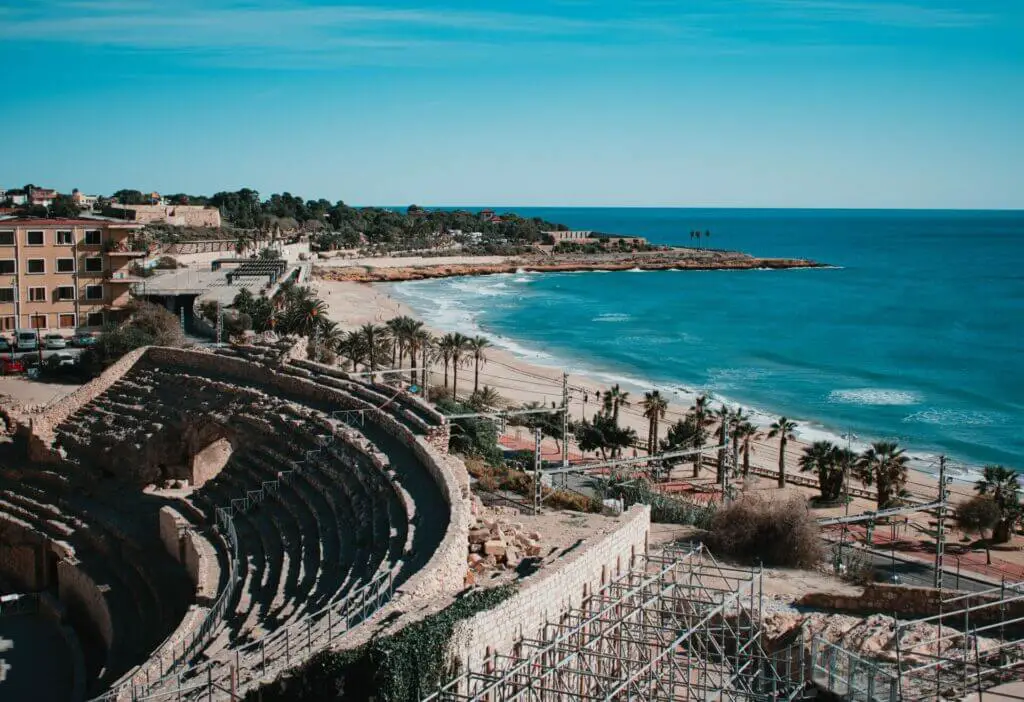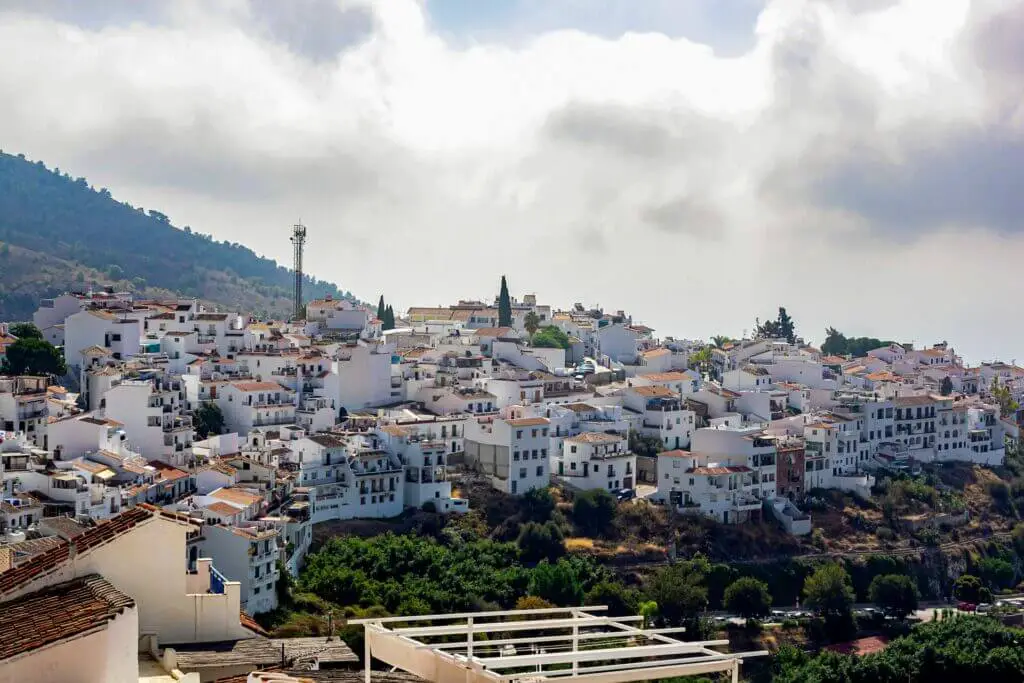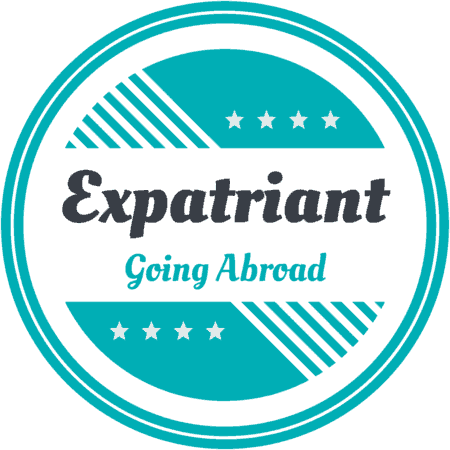Spain is one of the most popular destinations in the world, but there’s not one must-see like the Eiffel Tower or Great Wall. So we thought it’s worthwhile to feature a few less-famous places where we recommend spending a few days. Below I’ll share seven of my favorite places to get off the beaten path in Spain. Even better, six of the seven are just an hour from Madrid, Barcelona, or Málaga.
Tarragona: expansive Roman ruins and a Mediterranean lifestyle

Get off the beaten path near Barcelona in Tarragona, one of the best places to see Roman ruins in Spain. It’s just an hour south of Barcelona and a charming city now. Tarragona was once a sprawling provincial capital of the Roman Empire. Spend a day or two roaming (or Roming?) the impressive remains, including an amphitheater, a forum, a chariot track, and gigantic city walls. Here’s an excellent guide from the city’s tourism office.
Tarragona is also on the Mediterranean sea, with crystal-clear water, fresh seafood, and a history-laden seaside charm. The weather is as you would expect — pretty awesome, but it is a bit steamy in the summer. And with the great climate come all the outdoor sports, both on land and at sea. Try the new racquet sport of padel (which we covered in our article, Popular sports in Spain that aren’t soccer), or dive into a shipwreck off the coast. Tarragona is an excellent destination that most travelers skip.\
The “de Mar” beach towns north of Barcelona
If you find the southerly coasts of Spain hot and scrubby, or maybe you want to hear more French and Catalan than English or German on your beach holiday, give the “de Mars” a try.
Tossa de Mar, Lloret de Mar, Canyet de Mar — you can’t go wrong. They’re all beautiful beach towns with little castles scattered here and there with pleasant green hills behind. The water’s a bit colder than other beaches, but the sea is beautiful nonetheless. The best time to visit is in May, June, or September for good weather and fewer beachgoers.
Most de Mar towns are close to Barcelona by bus or train. The train runs from Barcelona as far as Blanes, and you can purchase a combined bus/train ticket from further away if needed.
Cuenca: a Moorish-Spanish cliff-hanging town and outdoor sports mecca
Directly between Madrid and Valencia and now on the high-speed rail line, this place is just waiting to be discovered. Start with the “hanging houses” and dozens of other buildings hovering high above the gorge of the river Huécar—Cuenca is a town custom-built for a postcard. Add an imposing 12th-century cathedral, a museum of abstract art inside those hanging houses, ruins, and castles in the countryside, and the perfect terrain for outdoor sports.
Go rock climbing in the morning, kayaking in the afternoon, and finish with a sunset hike for an unbelievable view. Or have the run through the little-visited Roman ruins (Segobriga), check out a restored medieval castle (Belmonte), and explore the historical tunnels of King Alfonso VIII. End the day with drinks and tapas in the quaint downtown with nigh another tourist in sight, and you’ve got the perfect off-the-beaten-path itinerary.
Cuenca is just an hour or two by rail, bus, or car from Madrid and Valencia. If you want to visit the ruins and castles outside of the town, renting a car or buying a tour from an agency is best. There are plenty of them scattered throughout the old city. And remember, it gets cold in Cuenca and even snows.
Pueblos Blancos: the white villages of the Sierra Nevada mountains

Surrounded by majestic chestnut forests in the heart of the Sierra Nevada, the pueblos blancos, or white villages, are another of Spain’s hidden gems. This part of Andalusia was the last bastion of the Moors in Spain, and that’s evident in the villages’ unique architecture.
It feels like a mix between North Africa and a Star Wars set wandering the ancient alleyways through multi-leveled whitewashed homes, all sprouting with fairy-mushroom chimneys. It’s something else.
These little towns are also in one of Spain’s premier hiking regions. Do some day hikes from village to village, and even catch a bus back up the hill if you like. Or get more ambitious and climb El Mulhacén, the highest peak in mainland Spain, on a one- or two-day adventure.
Buses run daily to the white villages from Malaga, Granada, Seville, and other nearby cities. Alternatively, you can book a private tour through a site like Get Your Guide.
Extremadura: a whole province under the radar
It may seem odd to list an entire province, but Extremadura deserves it. Extremadura is Spain’s most rugged and least-populated region. You can also think of it as Spain’s Wild West. It teems with natural beauty, wildlife, and thousands of years of history, but it’s nearly tourist-free.
The ancient walled city of Cáceres, A UNESCO World Heritage site, is an excellent place to base yourself in Extremadura. Its history spans thousands of years and has been a setting in countless shows and films. Lose yourself wandering streets unchanged for centuries among buildings blending Roman, Moorish, Gothic, and Italian Renaissance architecture.
Several hikes in the area mix history with natural landscapes, such as the Queen Isabella I and Emperor Charles V routes. Here’s a great resource for Extremadura’s best historical and natural hikes.
Extremadura is also famous for birdwatching due to its varied geography and sparse human population. Birdwatchers can check out this resource to get started.
The entire region is awash in historic sites, castles, ruins, and even ghost towns. Check out the Palaeolithic cave paintings in Cáceres, which may be Neanderthal and date back 67,000 years. Castle lovers should head for Castillo Albuquerque, near the Portuguese border, for the best combination of history, architecture, and setting if you’d like to explore a real ghost town, head for Granadilla, abandoned in 1955 when the Spanish government built a reservoir. And the biggest and best Roman ruin in Spain is also found in Extremadura, at Mérida.
Cáceres is about three hours southwest of Madrid by road or rail.
The Castles and Palaces of Segovia (plus more Roman stuff!)
Spain’s got castles all over the place, but I’d recommend the province of Segovia for a real fairy-tale experience. The Alcázar de Segovia was the inspiration for no less than Disney World’s Cinderella Castle. Add a Moorish fortress, a palace modeled after Versailles, and the 2,000-year-old city of Segovia for a great off-the-beaten-path itinerary.

The Alcázar de Segovia, at the city’s edge, is the crown jewel. Dating from the 12th century, it’s been completely restored and is now an expansive museum open to the public. It’s a genuinely immersive castle experience. The interiors are decorated to the hilt, there’s an armory, and you can even climb the tower. How cool is that?
The Castillo de Coca is both funky looking and very, very impressive. On the edge of a plain, it’s a rare moat fortress, as opposed to a hilltop structure. It’s one of the best examples of Mudejar architecture anywhere, and you can roam freely. Check that it’s open, though, as it hasn’t been recently.
After a castle and a fortress, how about a palace modeled after Versailles? The Royal Palace of La Granja de San Ildefonso was built in the early 1700s in what Wikipedia describes as rococo and “restrained baroque”, which sounds about right. It was the summer palace of Spanish royalty for 120 years and is now a museum and gardens open to the public.
Finally, don’t miss the 167-arch Roman aqueduct in the city of Segovia. It’s actually the reason most people visit!
Segovia is just one hour north of Madrid by road or rail.
Nerja: a myriad of beaches and activities on the splendid south coast
Nerja’s not exactly off-the-beaten-path, as it’s between Málaga and Granada, but many folks pass it by. It’s the perfect place for a few days of beach life and exploration on the south coast.
What I like about the beaches around Nerja is the variety. There are wide, busy beaches with all the amenities and hidden coves and niches down hundreds of stairs between the cliffs. You could spend a pleasant afternoon just descending every staircase to the sea you stumble upon. There’s even a nude beach and a dog beach outside the city.
Try Nerja by the sea in a kayak or SUP for a beautifully different perspective. Paddle the dramatic coastline and try not to get your camera wet. Or take to the air parasailing. Come back to land at sunset for a cold drink and fresh seafood on Playa Burriana.
There’s also plenty to do around Nerja. Take the kids spelunking or even attend a concert in the Caves of Nerja. Or hike to the top of El Cielo—that’s Heaven in Spanish—for otherworldly views of the Mediterranean and mountains. And don’t miss Frigiliana, just 20 minutes away, a gorgeous “white village” perched high above the sea.
To get to Nerja, well, you can’t miss it. It’s on the main highway between Málaga and Granada/Almería. The trick is to stop there and enjoy this great spot on Spain’s Costa del Sol!
Thinking about moving to Spain?
Whether you’ve been to Spain before or not, there are some things you should know before you move. In this post, I cover 17 things you should know about living Spain before you move.

